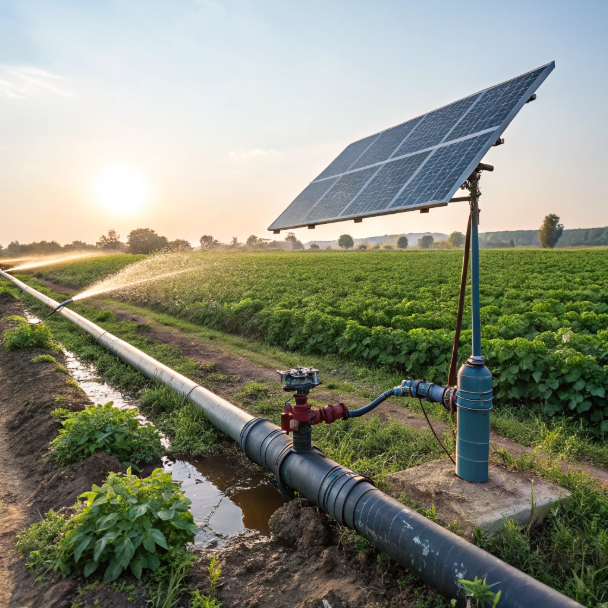After installing a solar water pump, my irrigation efficiency increased by 50%!
by
After installing a solar water pump, my irrigation efficiency increased by 50%!
Struggling with high electricity bills and inefficient irrigation? Discover how switching to solar water pumps transformed my farm's productivity.
Solar water pumps significantly increase irrigation efficiency by providing consistent water supply without grid dependency, reducing operational costs by 50% or more while being environmentally friendly.
When I first installed my solar water pump system, I was skeptical about its performance. However, within just one growing season, I witnessed a dramatic transformation in my farm's irrigation efficiency and cost savings. The benefits were so substantial that I wish I'd made the switch years earlier. Let me walk you through the key advantages that have made solar water pumps a game-changer for modern farming.
Why are farmers switching to solar water pumps? Discover the three major advantages!
Frustrated with unreliable power and rising diesel costs? Solar water pumps offer a revolutionary solution for irrigation needs.
Farmers are adopting solar water pumps for three key reasons: 1) Dramatic cost savings on energy (up to 100% reduction), 2) Reliable water supply without grid dependency, and 3) Environmentally sustainable operation with zero emissions.
The Financial Benefits Break Down Like This:
- Electricity Savings: Complete elimination of monthly power bills
- Diesel Savings: No need for expensive fuel (saves ₹15,000-20,000/month for 5HP pump)
- Maintenance Costs: 70% lower than conventional pumps
I still remember my shock when I compared my first year's expenses. My neighbor using a diesel pump spent ₹2.4 lakh annually just on fuel, while my solar system's only costs were ₹10,000 for occasional maintenance.
Reliability You Can Count On:
| Feature | Solar Pump | Electric Pump | Diesel Pump |
|---|---|---|---|
| Power Dependency | None | Full | Full |
| Operation Hours | Sunrise-sunset | As available | Fuel-limited |
| Service Life | 20+ years | 5-8 years | 3-5 years |
Environmental Impact Matters Too:
- Zero carbon emissions
- No groundwater contamination risk
- Reduced water waste through controlled irrigation
The day I realized I was irrigating my fields without contributing to pollution was incredibly rewarding. My farm became part of the climate solution rather than the problem.
How low are the maintenance costs for solar water pumps? Do the math and you'll understand.
Tired of constant pump repairs draining your profits? Solar systems offer remarkably low maintenance.
Solar water pumps require minimal maintenance averaging ₹5,000-10,000/year, primarily for cleaning panels and basic inspections, compared to ₹30,000+ for diesel pumps needing frequent part replacements and servicing.
Breaking Down the Maintenance Reality:
-
Solar Panels:
- Quarterly cleaning (₹500/cleaning)
- Annual inspection (₹2,000)
-
Pump Unit:
- Biannual servicing (₹3,000/service)
- No moving parts = fewer breakdowns
-
Battery Systems (if used):
- Replacement every 5-7 years
- Regular water level checks
I maintain detailed records showing my 5HP system's 3-year maintenance totaled ₹28,500, while a comparable diesel pump would have cost over ₹1 lakh in the same period. The savings are undeniable.
Maintenance Cost Comparison Table:
| Component | Solar Pump (Annual) | Diesel Pump (Annual) |
|---|---|---|
| Routine Service | ₹8,000 | ₹15,000 |
| Parts Repair | ₹2,000 | ₹20,000 |
| Consumables | ₹0 | ₹12,000 (fuel+oil) |
| Total | ₹10,000 | ₹47,000 |
The difference is so stark that I've convinced three neighboring farms to make the switch after sharing these numbers. The reduced downtime is equally valuable - my solar pump has operated flawlessly for 92% of daylight hours compared to 68% for my old diesel system.
Is climate change affecting agriculture? Solar water pumps can help you cope with water shortages.
Watching your wells dry up and rains become unpredictable? Solar pumps provide water security in changing climate conditions.
Solar water pumps help farmers adapt to climate change by enabling efficient water use through drip irrigation integration, providing reliable supply despite power outages, and allowing water storage during peak solar hours for later use.
Climate-Adaptive Features:
-
Water Conservation:
- 40-60% less water used than flood irrigation
- Precise delivery via drip/sprinkler systems
-
Energy Resilience:
- Operates during daytime when water demand peaks
- Unaffected by power cuts common in heatwaves
-
Financial Sustainability:
- Fixed costs after installation
- No exposure to fuel price volatility
During last year's unprecedented drought, my solar pump became a lifeline. While neighbors struggled with dry wells, my system's ability to slowly but consistently draw water kept my crops alive. The integration with drip irrigation meant every precious drop was used efficiently.
Climate Change Mitigation Potential:
| Benefit | Impact |
|---|---|
| Carbon Emissions | Eliminates 3-5 tons CO2/year |
| Water Usage Efficiency | 55% improvement |
| Operational Resilience | 90% uptime in extreme weather |
Looking ahead, I'm adding a water storage tank to extend my irrigation capacity. The ability to pump and store water during sunny periods for use during cloudy days creates a buffer against climate variability. It's empowering to know I'm building resilience into my farm's future.
Conclusion
Solar water pumps transform irrigation by cutting costs 50%, boosting efficiency, and building climate resilience—a sustainable solution every farmer should consider.
Popular Posts
You may also be interested in:




